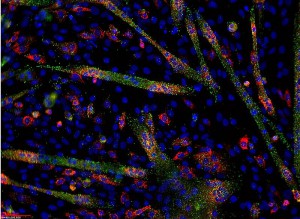 This week’s video takes us to a forest fire on Mauna Kea, a dormant volcano on the island of Hawaii. One of the firefighters captured this amazing video of a fire whirl that erupted as the air temperature near the ground grew very hot. Fire whirls like this one are caused by extreme heat rising from the ground rather than a confluence of atmospheric events, but they can be be every bit as destructive as atmospheric tornadoes and cause a forest fire to continue to burn out of control.
This week’s video takes us to a forest fire on Mauna Kea, a dormant volcano on the island of Hawaii. One of the firefighters captured this amazing video of a fire whirl that erupted as the air temperature near the ground grew very hot. Fire whirls like this one are caused by extreme heat rising from the ground rather than a confluence of atmospheric events, but they can be be every bit as destructive as atmospheric tornadoes and cause a forest fire to continue to burn out of control.
There are written records of fire tornadoes including several that developed after lightning struck an oil storage facility near San Luis Obispo, CA, USA in 1926. In 2003, scientists confirmed true fire tornadoes in Australia associated with the Canberra fires. In this case the fire tornadoes produced damage consistent with the intensity of an F2 tornado. In The Great Pestigo Fire in 1871, the town of Peshtigo, WI, may well have been consumed by fire tornadoes. Dry weather conditions and slash and burn farming practices contributed to this devastating fire (as they did the more famous Chicago fire that occurred on the same day). Strong winds carried a forest fire into the mill town of Peshtigo, WI, and researchers theorize that cut timber and wooden structures of the town fueled such intense heat that a massive fire whirls formed, consuming the town. You can read some compelling stories about the Peshtigo fire here and here.
Understanding the conditions under which firestorms and fire tornadoes form hopefully will lead to a better understanding of how forest and brush fires spread and allow scientists and fire control experts to develop more effective methods of control.






 The start of a new year is always a good time for reflection. For those of us at the BioPharmaceutical Technology Center Institute (BTC Institute), this means looking at the programs we offer and considering ones we might like to develop.
The start of a new year is always a good time for reflection. For those of us at the BioPharmaceutical Technology Center Institute (BTC Institute), this means looking at the programs we offer and considering ones we might like to develop.

